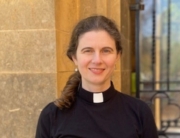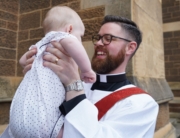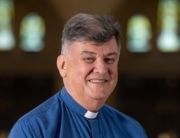Preacher: The Rev’d Canon Jenny Wilson
Matthew 14:22-36
In the name of God, creating, redeeming, sanctifying, … Amen.
“Do not be afraid,” Jesus said.
The question is why should we take his advice?
Jesus has just fed a large crowd and he seems to need some time alone. Before he goes up a mountain by himself to pray, he encourages his disciples to get into a boat and set out on the sea. When evening comes, though, a storm arises and the boat, battered by the waves and the wind, is far from the land. Early in the morning, Jesus comes walking towards the disciples on the lake. But when they see him walking on the lake, they are terrified, crying out in fear, saying, ‘It is a ghost!’ Immediately Jesus speaks to them and says, ‘Take heart, it is I; do not be afraid.’
Jesus’ whole life story is enclosed with these words, “Don’t be afraid”. The angel Gabriel speaks them to his mother, Mary, before Jesus’ conception – “Do not be afraid for you have found favour with God” (Luke 1:30)– and, at the end of Jesus’ life story, angels speak to the disciples who come looking for Jesus’ body at his tomb three days after his death, saying those same words “Do not be afraid.” (Matthew 28:5)Woven through the Old Testament, as well, the prophets repeatedly exhort the people of Israel to abandon fear. “Do not be afraid for I have redeemed you. I have called you by name. You are mine.” God says through the prophet Isaiah in one of my very favourite passages in the prophet’s writings. (Isaiah 43:1)
Fear seems to be a key aspect of the human condition and God knows this and God urges against it.
The boat in which the disciples are travelling is floundering on a stormy sea with the wind and the waves against them. We get this don’t we? Stormy seas and the fear that accompanies them. Human life is woven with this. Sickness does this, a serious illness can overwhelm and threaten to drown us. The death of a loved one does this, the death of one we cannot, perhaps years after their death, imagine that we must live without. The way of a world in which “terrorism” is a household word does this. Terrorism isn’t about killing people, don’t you see. Those two planes didn’t fly into the twin towers in New York all those years ago to kill people. The lives lost were just collateral damage. The aim was terror. The purpose was the image. The idea was a television image that would breed terror in us. And then there is this planet that is our home. Our home is under threat. We might well worry about how we can adequately care for it. Especially when one world leader is trying to remove the words “climate change” from his country’s vocabulary. We might, wisely, be frightened by that. Yes, we know about fear.
And the stormy sea with the winds and the waves and the little boat floundering on it is an image which gives much insight into fear. Insight into what seems to be our powerlessness in it.
In the gospel story, though, this boat is not alone. Early in the morning Jesus comes walking towards the boat on the lake. It is very important when we engage with a scriptural text, with any text, that we understand its language, that we ask of it the right questions. As we know, from the opening verses of the creation account in Genesis, the sea, in biblical thought, illustrates the forces of chaos, those forces held at bay by God’s creative power. And, again, in the narratives of the scriptures, it is only God that walks on the sea. Little wonder the disciples, who think Jesus is praying up a mountain, are further terrified by his presence. “Take heart, it is I; do not be afraid.” Jesus says. “It is I” or “I am” is God language, is reminiscent of God saying “I am who I am” to Moses by the burning bush. God is present with the disciples in the boat on the stormy sea.
Before we begin to engage with Peter’s response to Jesus we need to ponder this presence. The whole gospel is about it. We have said that the stories of Jesus’ life begin and end with angels telling people not to be afraid. There is something beyond this. Something holding frightened humanity. A presence. Matthew’s gospel is bookended with the fact of this presence, surrounded by an assertion of this presence. In the opening chapter of the gospel according to Saint Matthew, an angel tells Joseph in a dream not to be afraid to take Mary as his wife and the gospel’s narrator comments that her child will be named “Emmanuel, God with us.” (Matthew 1:20-23) As the gospel draws to a close, in the final verse, in fact, we see Jesus saying to his disciples “Remember, I am with you always, to the end of the age.” (Matthew 28:20) If the writer of this gospel would have us remember one thing it is that God is with us. That even, perhaps particularly, when we are afraid, God is with us. And the image of Jesus walking on a sea where the wind is howling and the waves are threatening to overturn any boat travelling upon that sea is a powerful sign of that presence. We would be wise to notice that Jesus does not seem to be bothered about the sea. It is the fear of his disciples that has engaged his attention.
Any text from scripture tells us something about God and something about what it is to be a human being. And if we can allow that story to sit alongside our human story we can be transformed by it. God is with us, walking alongside us on our stormy seas. But how can that help us?
Rowan Williams in his book about language, The Edge of Words, writes about how Jesus and the writers of scripture use narrative, story, to help us engage with the idea, the possibility of God. He says, “God is represented by a whole narrative; to enter into this story and discover where you as a hearer fit and what role it is possible for you do adopt imaginatively, is to become able to offer a representation that claims truthfulness …”[1] In other words the truth about God is often too difficult to engage with as a definition or an assertion. If we were simply to say, “Everything will be OK because God is with us,” we may find ourselves incredulous or unmoved. The truth about God, though, may be found in a story, may reach us through a story. And the truth of God in the presence of frightened humanity may be found here in the story of Peter and his response to Jesus’ presence walking on the water.
The first thing Peter does is engage with Jesus. We know fear can render us incapable of response, but Peter’s fear does not do this. The word courage has the word heart woven into it – he has literally taken heart as Jesus put it –he tries to trust Jesus. Peter takes courage and names Jesus “Lord” and says ‘Lord, if it is you, command me to come to you on the water.’ And Jesus says, ‘Come.’ But the fear is not defeated. I guess we can all relate to what happens next.
Peter looks at Jesus, looks at the one who gives him courage as he sets out across the stormy sea – and then he changes the object of his gaze. When Jesus has bidden Peter follow him out onto the water that day, all of a sudden all Peter could see was the wind and the waves and he lost sight of Jesus standing just a little way away. And don’t we know that feeling. When we step out in faith on an adventure we have longed to go on or we decide that we can embrace a struggle that we cannot seem to avoid and then we find ourselves wondering what on earth we have taken on and how earth we will manage it. Fear takes over.
But, again, when Peter notices the strong wind,* and becomes frightened, and begins to sink, he cries out, ‘Lord, save me!’ Peter trusts Jesus just enough to call to him. Again, the fear does not freeze him into inaction. Peter prays. And Jesus immediately reaches out his hand and catches hold of Peter, saying to him, ‘You of little faith, why did you doubt?’
All through this, as the sea rages and the wind howls, Jesus and Peter engage. Jesus willing Peter to have faith – Peter longing to act in faith. Faith and fear and doubt and love swirling in the midst of that terrifying sea. And, in the end, Jesus catching hold of Peter and both of them step into the boat and the wind ceases and the sea is calm.
God is with us, do you see? There could just be the sea and fear. That might be all there is. And some days it seems like all there is. But the whole of the biblical text and the whole of the life and death and resurrection of Jesus is saying that the sea and fear is not all there is.
And our part, like Peter, is to cry out, because even a frightened cry is an act of faith. That may be all we can manage at first. To cry out and to step out because the stories of scripture and the one to whom we will hold out our hands this morning for bread and wine are all about us trusting that it is just possible that we are not alone. That God is with us. And that living in that truth will calm the stormiest of seas. Will bring light and life in the darkest and most frightening places.
[1] Rowan Williams The Edge of Words p149.





